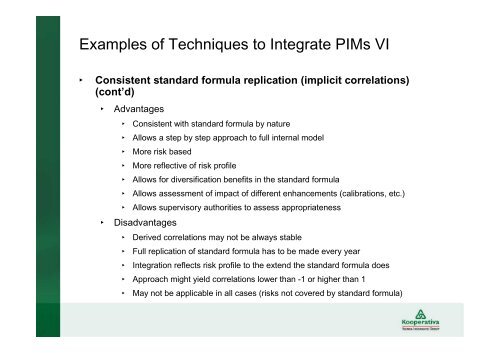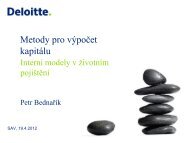Consistent standard formula replication (implicit correlations)
Consistent standard formula replication (implicit correlations)
Consistent standard formula replication (implicit correlations)
Create successful ePaper yourself
Turn your PDF publications into a flip-book with our unique Google optimized e-Paper software.
Examples of Techniques to Integrate PIMs VI<br />
‣ <strong>Consistent</strong> <strong>standard</strong> <strong>formula</strong> <strong>replication</strong> (<strong>implicit</strong> <strong>correlations</strong>)<br />
(cont’d)<br />
‣ Advantages<br />
‣ <strong>Consistent</strong> with <strong>standard</strong> <strong>formula</strong> by nature<br />
‣ Allows a step by step approach to full internal model<br />
‣ More risk based<br />
‣ More reflective of risk profile<br />
‣ Allows for diversification benefits in the <strong>standard</strong> <strong>formula</strong><br />
‣ Allows assessment of impact of different enhancements (calibrations, etc.)<br />
‣ Allows supervisory authorities to assess appropriateness<br />
‣ Disadvantages<br />
‣ Derived <strong>correlations</strong> may not be always stable<br />
‣ Full <strong>replication</strong> of <strong>standard</strong> <strong>formula</strong> has to be made every year<br />
‣ Integration reflects risk profile to the extend the <strong>standard</strong> <strong>formula</strong> does<br />
‣ Approach might yield <strong>correlations</strong> lower than -1 or higher than 1<br />
‣ May not be applicable in all cases (risks not covered by <strong>standard</strong> <strong>formula</strong>)






